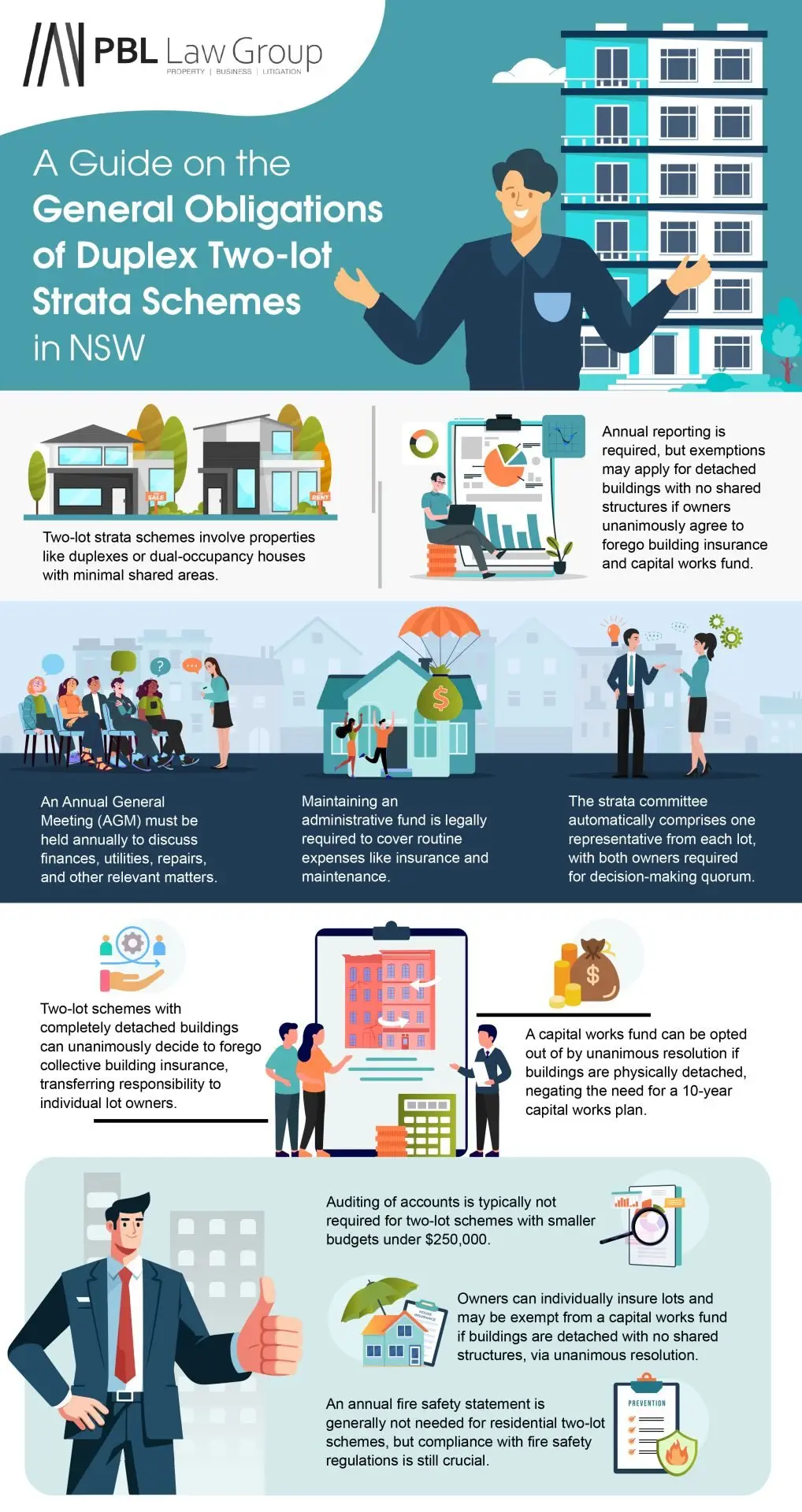Introduction
In New South Wales (NSW), two-lot strata schemes-often seen in duplexes or dual-occupancy residences-constitute a unique type of property ownership. Governed by the Strata Schemes Management Act 2015 (NSW) (SSMA), these arrangements combine elements of individual ownership with shared responsibilities, creating unique management considerations compared to larger strata complexes.
Understanding the specific obligations and operational requirements under the SSMA is essential for current and prospective owners in these schemes. This guide provides an overview of key responsibilities, including reporting duties, meeting procedures, financial management of administrative and capital works funds, insurance requirements, and decision-making processes pertinent to two-lot strata arrangements.

Understanding Two-lot Strata Schemes
Two-lot strata schemes refer to property arrangements limited to just two lots-commonly duplexes or houses divided into two. In these schemes,each dwelling functions as a separate lot with minimal or no shared areas,known as common property.
According to the SSMA,schemes are classified by size:
- Larger schemes have 100 or more lots.
- Other schemes, including two-lot schemes, have fewer than 100 lots.
Despite their relative simplicity, two-lot strata schemes present several unique challenges:
- Limited common property: Detached or semi-detached dwellings restrict shared spaces, affecting responsibilities for insurance, maintenance, and financial contributions.
- Voting dynamics: Equal voting rights mean that passing a unanimous resolution can be difficult.
- by-laws: Standard model by-laws may not suit these small schemes, necessitating the drafting of special by-laws tailored to their needs.
- Management structure and costs: The typical governance framework and associated expenses may seem unnecessary or excessive for just two lots.
By understanding these distinctions and challenges, owners can better tailor governance and by-laws to suit the scale and needs of their two-lot strata scheme.
General Obligations of 2-lot Strata duplexes in NSW
Reporting Requirements
Two-lot strata schemes in NSW may be exempt from reporting on capital works and combined building insurance if all of the following conditions are met:
- Buildings on each lot are physically detached
- There are no other shared structures
- All owners unanimously agree to forego building insurance and a capital works fund
When these criteria apply, the scheme still must satisfy annual reporting requirements for its administrative fund, providing versatility tailored to the specific needs of smaller two-lot schemes.
Annual General Meetings
An Annual General Meeting (AGM) must be convened each year, and the strata report completed within three months of that AGM.
- For newly established schemes, the first AGM date need not appear in the initial annual report.
- For subsequent reports, the AGM date must be specified.
These requirements ensure regular,timely oversight and record-keeping for effective scheme administration.
Get legal advice you can rely on.
Contact us today.
How can two-lot strata owners hold an AGM?
Holding an AGM in a two-lot scheme is a key process that allows the scheme to discuss finances and other relevant matters, as well as plan for the upcoming year. Here are the steps to follow:
- Pick a Date: Choose a suitable date, time, and location for the AGM in agreement with the other owner. If necessary, the meeting can be held online.
- Ensure Both Owners Attend: It’s important that an owner from each lot is present for the AGM to proceed. If an owner cannot attend, they can appoint a proxy voter by completing a proxy appointment form.
- Go Through the Agenda and Take Minutes: The AGM should cover a range of topics, including:
- Attendance and Minutes: Verify the presence of an owner from each lot and consider a motion to accept the minutes from the previous AGM, if applicable.
- Utilities and Repairs: Discuss decisions regarding utility providers for any common property and address any building defects within the scheme, especially if covered by warranty periods.
- Discuss Finances: Proper financial discussion involves:
- Proposing and voting on a motion to accept the financial statements for the past period. For schemes exempt from a capital works fund, this pertains only to the administrative fund.
- Addressing how to handle any unpaid or overdue levies.
- Share the Minutes and Keep Records: Distribute a copy of the meeting minutes to each owner within seven days of the AGM. Additionally, maintain records of the meeting agenda, financial statements, and other relevant documents for at least seven years.
Administrative Fund
Maintaining an administrative fund is mandatory in all strata schemes, including two-lot schemes. This fund covers routine expenses such as:
- insurance premiums
- General maintenance and cleaning
- Administrative fees and utilities
Proper management of this fund ensures that day-to-day operations and minor repairs can be funded without delay.
Capital Works Fund
Under SSMA Section 74(5), two-lot schemes with physically detached buildings may, by unanimous resolution:
- Opt out of establishing a capital works fund
- Waive the requirement for a 10-year capital works plan (Section 80)
By contrast, larger schemes must maintain a capital works fund and plan, and comply with Section 76’s rules on transferring money between funds. This exemption grants two-lot schemes greater financial flexibility.
Insurance
SSMA Section 160(4) allows two-lot schemes with wholly detached buildings to unanimously decide to forego collective building insurance. In such cases:
- Individual owners insure their own lots
- Insurance costs are often shared equally to simplify administration
- The scheme avoids the complexities of formal owners corporation insurance arrangements
Management and Decision-Making
While managing a two-lot scheme is generally more straightforward, owners must still comply with key SSMA provisions:
- Strata Committee: No formal election-each lot automatically has one representative.
- Quorum: Both owners must be present for valid decisions.
- General Management: Includes compliance, reporting, maintenance and record-keeping duties.
Many two-lot schemes opt to engage a strata managing agent with a limited delegation to:
- Provide professional assistance on legal and administrative requirements
- Help resolve disagreements between owners
By balancing simplicity with due compliance, two-lot schemes can run smoothly while meeting all statutory obligations.
Speak to a Lawyer Today.
We respond within 24 hours.
General Exemptions for 2 Lot Strata Schemes
Strata Committee Selection
In two-lot strata schemes, the strata committee reflects the scheme’s simplicity and smaller scale by automatically including one owner from each lot.
- If a lot is jointly owned, only a single co-owner may represent that lot.
- No formal election process is required.
This streamlined arrangement ensures equal representation and avoids administrative complexity in smaller schemes.
Auditing of Accounts and Financial Statements
Under Section 95 of the SSMA, only large owners corporations or those with annual budgets over $250,000 must undergo an audit. Given that two-lot schemes typically operate on smaller budgets, they generally fall outside this requirement.
- Exemption benefits:
- Reduced financial and administrative burden
- Fewer compliance obligations
As a result, two-lot schemes enjoy relief from auditing that larger schemes do not.
Individual Insurance
Owners in two-lot strata schemes may individually insure their lots and, under specific conditions, be exempt from establishing a capital works fund. These conditions are:
- buildings on each lot must be physically detached.
- No part of any building extends beyond its lot boundaries.
- Owners pass a unanimous resolution to forgo building insurance and/or a capital works fund.
This arrangement leverages the small scale of two-lot schemes to grant flexibility in insurance and fund requirements.
Annual Fire Safety Statement
Typically, residential two-lot strata schemes are not required to lodge an annual fire safety statement. However, owners must still:
- Ensure compliance with all relevant fire safety regulations
- Consult the local council for specific requirements and guidelines
By staying informed and proactive, owners maintain safety and legal compliance despite the exemption.
Conclusion
Managing a two-lot strata scheme in NSW involves specific obligations regarding reporting, meetings, financial funds, insurance, and decision-making, distinct from larger schemes. Understanding these requirements under the SSMA is essential for owners to ensure compliance, maintain harmony, and effectively manage their shared property interests.
If you own property in a two-lot strata scheme and require assistance navigating its unique legal framework or resolving disputes, seeking specialised legal advice from experienced NSW strata lawyers is recommended. Contact PBL Law Group today for expert guidance tailored to your specific situation and ensure your scheme operates smoothly and lawfully.







